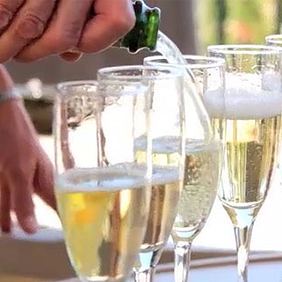‹ Back to Region
California Sparkling Wine
Details: Sparkling wine is a beverage that brings to mind several thoughts—celebration, success, luxury, love and romance. These pleasant associations seem to be as strong now as they ever were. And because the wine is offered with different levels of sweetness, menu planners use the wine as an aperitif or a versatile accompaniment to a variety of foods such as salty nuts and cheese, lightly-spiced fish and Asian dishes, fried foods, strawberries and more. California has more than 300 producers and shipped 11 million cases of sparkling wine/champagne to U.S. markets in 2016. Total U.S. and foreign-produced sparkling wine/champagne shipped to the U.S. in 2016 was 25.6 million cases. The category holds a 6.4 percent share of the U.S. wine market.
Several U.S. producers label their sparkling wines “champagne,” and the U.S. government allows the use of the champagne term on U.S. brands established on or before March 2006 as long as the geographic origin accompanies the champagne term on the label. New U.S. brands after this date are not allowed to use the champagne term. Traditional winegrape varieties used in California sparkling wine/champagne production are Chardonnay, Pinot Noir and Pinot Blanc, though many other varieties are used, depending upon the style, production process and price point.
Major Production Processes
Following are the two most common methods used for sparkling wine production:
Méthode champenoise—Still wine is used as a base wine in the process. A blend of base wine, yeast nutrient and a sugar source is added to the base wine. The mixture is sealed, fermented a second time and aged in the bottle, which captures the carbon dioxide released in the fermenting process producing the bubbles.
Charmat process—Still wines are fermented in a pressurized tank. Sugar and yeast are added for a second fermentation, but the wine remains in the tank for this stage of the process and is not fermented in individual bottles.
Styles
Sparkling wine ranges in style from very dry (Natural), dry (Brut), and slightly sweet (Extra Dry) to sweet (Sec and Demi-Sec). (Wines with no noticeable sweetness are described as “dry.”) Many sparkling wines are also identified as “Blanc de Blancs” (wines made from Chardonnay grapes), “Blanc de Noirs” (wines produced from black grapes), or rosé or pink sparkling wine/champagnes (small amount of red wine added to the blend or wine that is allowed brief skin contact with color-laden grape skins).
Top 10 U.S. Metro Markets for Sparkling Wine/Champagne in 2015:
(Thousands (000) of 9-liter cases)
| New York-Newark-Edison | 2,025 | Miami-Ft. Lauderdale-Miami Beach | 479 |
| Chicago-Naperville-Joliet | 1,754 | Riverside-San Bernardino-Ontario | 472 |
| Los Angeles-Long Beach-Santa Ana | 1,559 | Detroit-Warren-Livonia | 429 |
| San Francisco-Oakland, Fremont | 633 | San Diego-Carlsbad-San Marcos | 393 |
| Boston-Cambridge-Quincy | 485 | Washington, DC-Arlington-Alexandria | 386 |
Source: 2016 The Beverage Information Group.
Top 10 States for Consumption of Sparkling Wine/Champagne in 2015:
(9-liter cases)
| 1. California | 4,220,700 | 6. Michigan | 949,700 |
| 2. Illinois | 2,087,100 | 7. New Jersey | 770,400 |
| 3. New York | 1,858,900 | 8. Pennsylvania | 567,900 |
| 4. Florida | 1,427,900 | 9. Massachusetts | 550,400 |
| 5. Texas | 1,163,500 | 10. Ohio | 425,800 |
Source: 2016 The Beverage Information Group.






